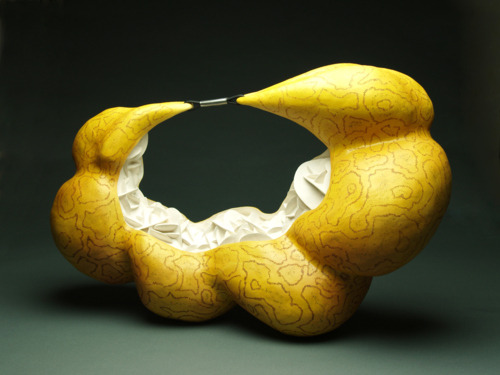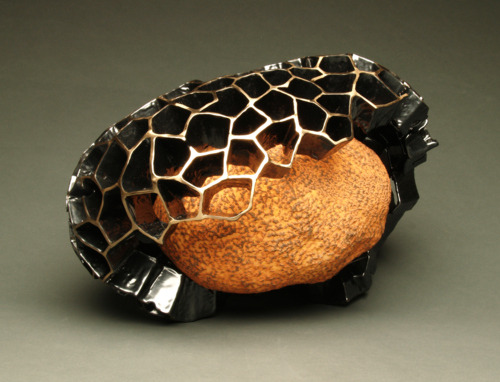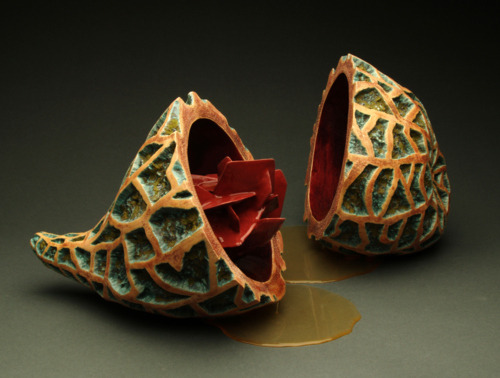
You are strengthening your career as a ceramic artist year by year. What was your first contact with ceramics and when did you realize you have a passion for it?
I took a ceramics class in my junior year in college, and that changed my world instantly. I was constantly in the studio. I had worked with wood and metal prior to clay, but it was amazing to find one material that possesses the qualities of many materials. Throughout its various stages, clay is plastic at first, then flexible and strong like wood, then hard like steel. This is over simplified, but basically I love the metamorphic qualities of clay. It is an incredible material that twenty years later, I am still very passionate about.
What is the most difficult part in constructing a new piece? Tell us about your creative process, from sketches to the final display.
I usually work on multiple pieces at one time, so that they feed off of each other as a series. My work is often an amalgamation of forms and details from mostly natural objects and landscapes. I have a lot of natural objects and photographs around my studio. I use these details as a starting point for the forms and surfaces that I create, often manipulating the scale or color of the details that I am interested in.
I often start by sketching in a notebook to quickly work through ideas; then I move to a large chalkboard for some full-scale sketching. My sketches are often covered in words that inform the themes I am working on. Once I can visualize the form, I want to create I move on to construction, my favorite part.
The most difficult part of constructing my larger work is managing the appropriate humidity. I allow certain areas to dry enough so that they have the strength to support the form while other areas are wet enough so that I can continue adding more clay. All of this happens while maintaining a smooth gradation of humidity between those areas to avoid cracks. I spend several weeks working on one piece, often jumping between other pieces while I wait for one to dry enough.
I rarely build my work in the position that it will rest. This does two things. It makes it easier to move the piece around to work on it, and it keeps the orientation of the object open until the end of the building process. I can have most of the form completed and then cut and dart areas to modify the form. Once the main form is completed, I smooth and refine the surface. This step is very meditative for me. It has a rhythm and fluidity that I enjoy.
I do get a little bit stressed when I go to load the kiln. The more time I put into something, the higher the level of stress I feel. I fire most of my work multiple times in the low fire range (1800-2000 F / 980-1100 C). The first glaze firing is the highest with each successive firing happens at lower temperatures until I get my desired surface. Once I am done with the glaze firings, I start incorporating the manufactured elements.
You have been working with all sorts of techniques and have experienced different themes and subjects, but, above all, you are also teaching college level courses. How do you find the right balance between practice and teaching?
I love sharing my knowledge and experience with people. Seeing the students’ excitement and being a part of their progression as artists is very satisfying. Teaching has defined parameters and time to work with the students. When I am not teaching I am in my studio every day and available to the students. I enjoy being in the studio so much that my more difficult balancing act is between studio time and personal time with outdoor recreation. Not giving myself enough time to play, and recharge has been difficult during graduate school.

Pulse, 2011, Ceramic, glaze, bronze and powder coating, 9H x 14W x 10D inches
You are approaching a very contemporary subject in today’s world – the natural environment. Have you been determined by a particular experience to choose this topic? How important is the conceptual component for your work?
I have always had great admiration for the natural world. I have a long history of backpacking on the coastline and in the mountains of the Western United States. My undergraduate degree is in environmental studies, which reflects my interest in the natural world. I eventually became interested in knowing where my food comes from. Through this investigation, I became aware of the dramatic changes that have taken place in the food production systems in America over the last 20 years. Organisms are being modified in ways that would not be possible without the intervention of scientists. Here in the U.S.A. genetically modified food is not labeled. I feel it is important for people to know what they are eating.
It is important to me that my work sustains a balance between beauty and concept. I hope that my art will encourage viewers to educate themselves about the food production system. However, I have little control over what each person will pick up from my work conceptually. If they are pleased with the form and find it visually interesting, then I can feel satisfied. Ultimately, I would like the viewer to be affected by my work and compelled to ask questions and about their relationship with the environment, thereby becoming increasingly proactive in assuring a sustainable future.

What are you working on next and where can we find your works in the near future?
My most recent work incorporates a larger percentage of metal with ceramic materials and examines genetic modification. I am currently working on a series that investigates people’s perception of the storage, use and consumption of energy sources. This work will be in my thesis exhibition.
You can find one of my sculptures at the National Student Juried Exhibition in Seattle Washington as part of the National Council on Education for the Ceramic Arts Conference from March 6th – 31st 2012. Additionally, my Master of Fine Arts thesis solo exhibition will be at the William T. Kemper Gallery in Manhattan Kansas U.S.A. from April 16th – 27th 2012.
By Alexandra Mureşan and Vasi Hîrdo
Published in Ceramics Now Magazine Issue 2
View Steve Belz’s profile on Ceramics Now.
Visit Steve Belz’s website.



















